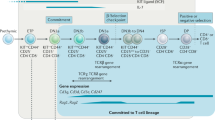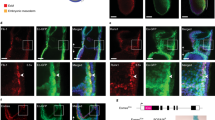Abstract
CHROMOSOMAL translocations associated with malignancies often result in deregulated expression of genes encoding transcription factors1. In human T-cell leukaemias such regulators belong to diverse protein families and may normally be expressed widely (for example, Ttg-1/rbtnl, Ttg-2/rbtn2) 2,3, exclusively outside the haematopoietic system (for example, Hoxll) 4, or specifically in haematopoietic cells and other selected sites (for example, tal-1/ SCL, lyl-1) 5,6. Aberrant expression within T cells is thought to interfere with programmes of normal maturation. The most frequently activated gene in acute T-cell leukaemias, tal-1 (also called SCL) 7,8, encodes a candidate regulator of haematopoietic development9, a basic-helix-loop-helix protein5, related to critical myogenic10 and neurogenic11 factors. Here we show by targeted gene disruption in mice12 that tal-1 is essential for embryonic blood formation in vivo. With respect to embryonic erythropoiesis, tal-1 deficiency resembles loss of the erythroid transcription factor GATA-113,14 or the LIM protein rbtn215 .Profound reduction in myeloid cells cultured in vivo from tal-1 null yolk sacs suggests a broader defect manifest at the myelo-erythroid or multipotential progenitor cell level.
This is a preview of subscription content, access via your institution
Access options
Subscribe to this journal
Receive 51 print issues and online access
$199.00 per year
only $3.90 per issue
Buy this article
- Purchase on Springer Link
- Instant access to full article PDF
Prices may be subject to local taxes which are calculated during checkout
Similar content being viewed by others
References
Rabbitts, T. H. Nature 372, 143–149 (1994).
Boehm, T. et al. EMBO J. 7, 385–394 (1988).
Royer-Pokora, B., Loos, U. & Ludwig, W.-D. Oncogene 6, 1887–1893 (1991).
Roberts, C. W. M., Shutter, J. R. & Korsmeyer, S. J. Nature 368, 747–749 (1994).
Begley, C. G. et al. Proc. natn. Acad. Sci. U.S.A. 86, 10128–10132 (1989).
Mellentin, J. D., Smith, S. D. & Cleary, M. L. Cell 58, 77–83 (1989).
Brown, L. et al. EMBO J. 9, 3343–3551 (1990).
Aplan, P. D. et al. Science 250, 1426–1429 (1990).
Visvader, J., Begley, C. G. & Adams, J. M. Oncogene 6, 187–194 (1991).
Olson, E. N. & Klein, W. H. Genes Dev. 8, 1–8 (1994).
Guillemot, F. et al. Cell 75, 463–476 (1993).
Capecchi, M. R. Science 244, 1288–1292 (1989).
Pevny, L. et al. Nature 349, 257–260 (1991).
Weiss, M. J., Keller, G. & Orkin, S. H. Genes Dev. 8, 1184–1197 (1994).
Warren, A. J. et al. Cell 78, 45–57 (1994).
Tsai, S. F. et al. Nature 339, 446–51 (1989).
Mucenski, M. L. et al. Cell 65, 677–689 (1991).
Wong, P. M. C., Chung, S. W., Chui, D. H. K. & Eaves, C. J. Proc. natn. Acad. Sci. U.S.A. 83, 3851–3854 (1986).
Rudnicki, M. A. et al. Cell 75, 1351–1359 (1993).
Aplan, P. D., Nakahara, K., Orkin, S. H. & Kirsch, I. R. EMBO J. 11, 4073–4081 (1992).
Kallianpur, A. R., Jordan, J. E. & Brandt, S. J. Blood 83, 1200–1208 (1994).
Hwang, L.-Y., Siegelman, M., Davis, L., Oppenheimer-Marks, N. & Baer, R. Oncogene 8, 3043–3046 (1993).
Valge-Archer, V. E. et al. Proc. natn. Acad. Sci. U.S.A. 91, 8617–8621 (1994).
Tybulewicz, V. L. J., Crawford, C. E., Jackson, P. K., Bronson, R. T. & Mulligan, R. C. Cell 65, 1153–1163 (1991).
Ausubel, F. M. et al. Curr. Prot. molec. Biol. (1987).
Begley, C. G. et al. Proc. natn. Acad. Sci. U.S.A. 88, 869–873 (1991).
Li, E., Bestor, T. H. & Jaenisch, R. Cell 69, 915–926 (1992).
Tsai, F.-Y. et al. Nature 371, 221–226 (1994).
Chomczynski, P. & Sacchi, N. Analyt. Biochem. 162, 156–159 (1987).
Keller, G., Kennedy, M., Papayannopoulou, T. & Wiles, M. V. Molec. cell. Biol. 13, 472–486 (1993).
Author information
Authors and Affiliations
Rights and permissions
About this article
Cite this article
Shivdasani, R., Mayer, E. & Orkin, S. Absence of blood formation in mice lacking the T-cell leukaemia oncoprotein tal-1/SCL. Nature 373, 432–434 (1995). https://doi.org/10.1038/373432a0
Received:
Accepted:
Issue Date:
DOI: https://doi.org/10.1038/373432a0
This article is cited by
-
TAL1 hijacks MYCN enhancer that induces MYCN expression and dependence on mevalonate pathway in T-cell acute lymphoblastic leukemia
Leukemia (2023)
-
Identifying a novel role for the master regulator Tal1 in the Endothelial to Hematopoietic Transition
Scientific Reports (2022)
-
Exposure to hypoxia causes stress erythropoiesis and downregulates immune response genes in spleen of mice
BMC Genomics (2021)
-
The T-box transcription factor Eomesodermin governs haemogenic competence of yolk sac mesodermal progenitors
Nature Cell Biology (2021)
-
Enhancer rewiring in tumors: an opportunity for therapeutic intervention
Oncogene (2021)
Comments
By submitting a comment you agree to abide by our Terms and Community Guidelines. If you find something abusive or that does not comply with our terms or guidelines please flag it as inappropriate.



